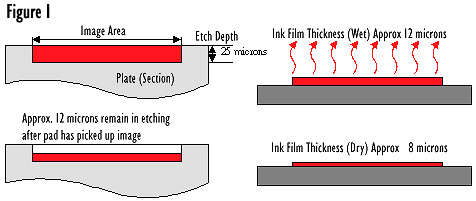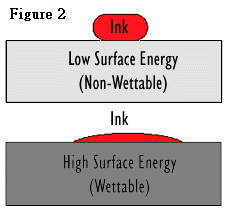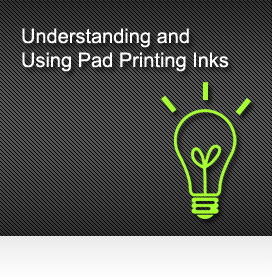
Pad printing inks consist of the following components:
- resins (20%) -- primarily responsible for forming the finished ink film and carrying the colorant. The nature of the resin determines what type of curing method will be used.
- pigments (or dyes) (17%) -- impart the colour and opacity to the finished print. They are incorporated into the ink by the manufacturer through a mechanical dispersion process.
- solvents (60%) -- enable the resin-pigment mixture to be transferred to the substrate during printing. Pad printing requires fast-evaporating solvents to enable the ink to transfer. The exact choice and amount of solvents will depend on the resins, pigment and substrate used in the ink. For most inks, no single solvent will have all the desired properties, so a mixture of solvents is used.
- minor additives (3%) -- include plasticizers and surfactants designed to improve the ink's flexibility, flow, pigment stability and other characteristics. Without them, the ink would suffer such defects as brittleness, poor film strength, pigment separation and unsatisfactory flow.

Ink types
The ink systems currently available to the industry fall into 7 different categories:
- solvent evaporating -- predominant in the pad-printing industry. They dry very rapidly through solvent evaporation alone. Care must be taken when printing non-absorbent materials with these inks, as absorbency is required to give best adhesion. A simple way to tell if a solvent based ink is suitable for a particular plastic is to rub the solvent used to thin the ink onto the substrate. If the solvent melts the surface of the plastic, chances are the ink will adhere very well.
- oxidation curing -- the resin absorbs oxygen from the atmosphere and undergoes a polymerization process, producing a very tough, flexible, weather-resistant ink film. They have limited uses in pad-printing applications due to their slow drying speed, but they are excellent for printing onto metal and glass.
- reactive (i.e., catalyst curing, two component) -- also contain resins capable of polymerization. The inks have a restricted shelf life once the catalyst is added.
- baking -- need a certain minimum temperature and time to cure. The cure time varies inversely with the temperature: the higher the temperature, the shorter the drying time.
- UV curable -- widely used in the screen printing industry, offering faster curing speeds, ease of printing, and fewer environmental problems than solvent-based systems. Since UV inks contain no solvents, they can't rely on solvent evaporation in the printing process as ordinary inks do. However, because the inks contain no evaporative liquids, the cured ink film is much closer to the wet ink film than with conventional inks. The thickness of the ink film must be carefully controlled or else curing will be very difficult. For a pad printer, the big advantage of UV technology is that small changes in ambient conditions won't affect it, giving much greater stability to the process.
- sublimation -- involve a special process where a solid turns into a gas when heated. When these inks are applied to an appropriate surface and then heated to the specified temperature (approximately 392°F or 200°C), dyes in the ink sublime, the surface of the material becomes porous, and the dyes pass into the material. This actually changes the colour of the base material. Once the material has cooled, the ink is sealed into the surface.
- ceramic and glass -- similar to the ones used in screen printing in that at ambient temperatures, the ink is solid (like candle wax). It becomes fluid when raised to 176°F (80°C).

Ink selection - substrate concerns
 If the surface tension of an ink is greater than the surface energy of the substrate, the ink will bead up rather than flow properly. To make such a substrate wetable and enable ink adhesion, substrate pretreatment is necessary. In order for an ink to adhere to a substrate, it must be capable of wetting the material. If this is to occur, the surface tension of the ink must be lower than the surface energy of the substrate (Figure 2). If the surface tension of an ink is greater than the surface energy of the substrate, the ink will bead up rather than flow properly. To make such a substrate wetable and enable ink adhesion, substrate pretreatment is necessary. In order for an ink to adhere to a substrate, it must be capable of wetting the material. If this is to occur, the surface tension of the ink must be lower than the surface energy of the substrate (Figure 2).
Contamination in the form of oil, grease silicones, condensation, etc., will inhibit or stop ink from wetting the surface. Cleanliness is essential. Ink that appeared to have adequate adhesion can simply fall off when slip additives migrate to the surface.
Other factors affecting ink performance include substrate pretreatment, performance of individual cured ink and post treatment process.
In pad printing, the ink may be the most important element of the process, yet it is constantly abused. Always carry out tests on the substrate before going into production. Materials do change and problems can occur. Take a systematic approach to choosing, testing, preparing, and using your inks, and you'll see a world of improvement in your pad printing operation.

Rules of using ink
- Read the technical data sheets.
- Read and understand the Health and Safety Data Sheet.
- Always wear protective clothing, gloves, and goggles when mixing inks.
- Ensure that ventilation is adequate at all times.
- Stir ink and hardeners before use.
- Use only specified solvents.
- Weigh the ink, solvent, hardener, components, and mixture.
- Do not use inks or hardeners that are past their shelf life.
- Seal partly used cans of ink. Their shelf life is reduced once opened.
- Keep unused mixed ink in a closed container.
- Do not used mixed two-component ink after pot life is expired.
- Do not use two-component inks in closed-cup printing system.
- If single-component ink is used, continuously change every two days.
- Never Mix ink types to achieve a color match.
- If ink splashes onto your skin, wipe off excess with tissue or cloth and wash with soap and water or proprietary hand cleaner.
- Never us thinners to remove ink form skin.
- If ink or solvents enter your eye, irrigate with water for 15 min and seek medical advice immediately.
- In case of swallowing, do not induce vomiting. Seek medical advice immediately.
- In both the above cases, take the Health and Safety Data Sheet and the Technical Data Sheet to the medical authority.

Peter Kiddell
Peter Kiddell has been in the pad printing industry for more than 20 years and currently works as a pad and screen printing consultant. His company, PDS Consulting, develops training packages to help companies fine tune their pad printing process. He or his partner, Carol Burnside, may be contacted at:
PDS Consulting, Innovation Way, Barnsley S75 1JL, South Yorkshire, England
Tel: +44(0)1226 249590 Fax: +44(0)1226 294797
Email: peter@pdsconsulting.co.uk Web: http://www.pdsconsulting.co.uk |
